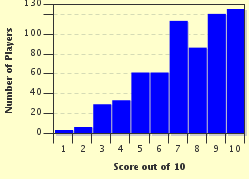Quiz Answer Key and Fun Facts
1. A member of Britain's Royal Navy helped to standardize weather forecasting by developing a "wind force scale" which reduced subjective observations. Who was he?
2. One of the world's foremost theoretical physicists, this man published many books including "A Brief History of Time" and "The Universe in a Nutshell". Who was he?
3. After Einstein published his theories, a herd of nerds appeared, ready to carry his ideas forward with experiments and observations of their own. Who was well known for his 'uncertainty principle'?
4. "Cause I'm radioactive" sang The Firm. If it hadn't been for this nerd, who coined the term "radioactive", they wouldn't have had anything to sing about. Who coined the term?
5. A World War II British codebreaker went on to become one of the fathers of modern computing and artificial intelligence. Who was the man who worked to decipher the codes of the German Enigma machine?
6. There is the "wind force scale " for sea-borne winds but there is a scale to measure tornado intensity on land. Who developed it?
7. Another member of the herd of quantum physicists was a man who illustrated his theory by use of a cat, a box, some radioactive material, and more. Who was he?
8. At one time mankind thought the Milky Way galaxy was the only galaxy. Who determined that some of the stars and nebulae astronomers were looking at were actually separate galaxies?
9. Did your car start up when you turned the key today? Yes or no, you can thank the man who invented the battery. Who was that man?
10. One of the most widely respected scientists of all time laid much of the foundations of modern physics and mathematics. He also knew what would happen to the apple on William Tell's son's head after Tell split it. Who are we talking about here?
Source: Author
CmdrK
This quiz was reviewed by FunTrivia editor
bloomsby before going online.
Any errors found in FunTrivia content are routinely corrected through our feedback system.

